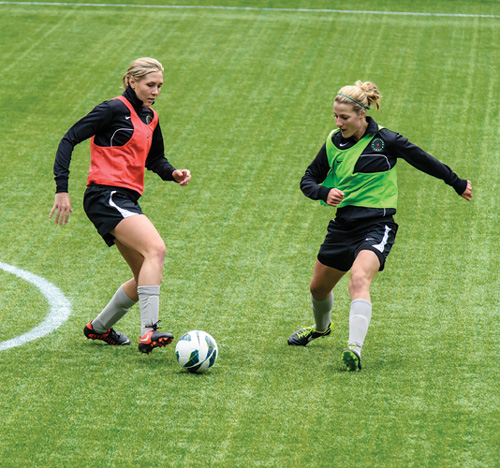 On March 16, my teenage son was among the hundreds of Oregonians who traveled north to watch the Portland Timbers play the Seattle Sounders. This game is a big deal, he informed me, well aware that my knowledge of things athletic is limited to kinder, gentler recreational activities such as bike commuting, camping and power walking around the neighborhood.
On March 16, my teenage son was among the hundreds of Oregonians who traveled north to watch the Portland Timbers play the Seattle Sounders. This game is a big deal, he informed me, well aware that my knowledge of things athletic is limited to kinder, gentler recreational activities such as bike commuting, camping and power walking around the neighborhood.
 |
Above: Portland Thorns midfielders Allie Long and Becky Edwards practice at Jeld-Wen Field.Below: Portland Thorns forward Danielle Foxhoven during the team’s first practice on March 11.// Photos by Joseph Eastburn |
 |
On March 16, my teenage son was among the hundreds of Oregonians who traveled north to watch the Portland Timbers play the Seattle Sounders. This game is a big deal, he informed me, well aware that my knowledge of things athletic is limited to kinder, gentler recreational activities such as bike commuting, camping and power walking around the neighborhood.
Between the two of us, my son and I represent the yin and yang of the Oregon athletics and recreation sector. As writer Jon Bell reports in this month’s cover story profiling eight game changers in the sports market, Oregon, like me, is not exactly known for being a sports powerhouse.
But as Bell observes, the state has also carved out a niche in certain sectors such as cycling, track and field, and soccer, a game my 18-year-old son has played since he was five. Add to that innovators in sports medicine and athletics technology — not to mention the spring debut of the Portland Thorns, the Timbers-backed National Women’s Soccer League team — and Oregon is starting to earn national recognition for its leadership in sports, on both the business and game fronts.
In this issue, we take a look at other industries and regions that might be considered rising stars, as well as pioneering players. My article on East Portland describes a neglected part of the city now creating innovative business models designed to revitalize, but not gentrify, languishing neighborhoods. One example is the Portland Mercado, the city’s first Latino public market, springing up near the Lents Urban Renewal Area in Southeast Portland.
Writer Dan Cook also reports on collaborative efforts to rebound the struggling timber industry in Eastern Oregon, where communities, timber companies and environmentalists are partnering to increase timber harvesting. The goal is to create jobs and keep mills open while restoring the health of overstocked, fire-prone forests.
Bringing together people with different interests to develop unique economic solutions and niche businesses seems to be the Oregon way, be it in resource management, urban development — or athletics. As for me, I’ll continue to ride my bike around the city, and my son will remain a big-time Timbers and Trail Blazers fan. Call it our familial way of upholding an enduring Oregon value: sportsmanship.
LINDA BAKER


